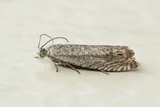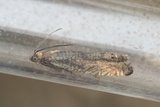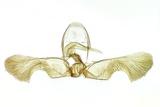Cydia medicaginis (Kuznetsov, 1962) Species
Last modified: Nov. 25, 2025, 12:15 p.m.
New to Belgium in 2021 in WV.
Details
- Classification
- Family: Tortricidae > Subfamily: Olethreutinae > Tribus: Grapholitini > Genus: Cydia > Species: Cydia medicaginis
- Vernacular names
- Luzernespiegelmot (NL), Alfalfa Moth (EN)
- Status
-
Native
Distribution
Imago
Wingspan 9–12 mm. Forewings monochromatic, grey-brown and with the scales tipped paler giving it a very fine peppered appearance. There is a weak ocellus edged with plumbeous grey. There are short strigulae on the entire length of the costa. Hindwing greyish.
Given the resemblance to Cydia microgrammana, determination via the genitals is necessary.
The adults come to different pheromones of Cydia species like Cydia fagiglandana and Cydia illutana.
Genitalia
Male: Cucullus not elongated, almost rounded, with isolated dent on ventral margin. Aedeagus with small projection situated post-medially on right side.
Female: Notch in posterior margin of seventh sternite deep. Sterigma in shape of ring surrounding ostium with weak and small, semisquare lamella postvaginalis. Ductus bursae sclerotized from inception of ductus seminalis to a little before ostium.
Egg
Eggs are laid singly or in a small row on young leaves.
Bionomics
The young larva penetrates a bud or a flower of the host plant where it feeds on the base of petals, causing the flower to dry. Later, the larva bores into the pods and feeds on the seeds.
They pass the winter fully fed in a cocoon on the ground in which they pupate in spring.
The moths fly at night and comes to light.
Flight periods
The adults are on the wing from early June towards late July.
Observed on
- Host plant (species):
- Medicago sativa
The larva lives on Medicago sativa.
Habitat
It inhabits rough ground, waysides and dry meadows where the host plant occur.



